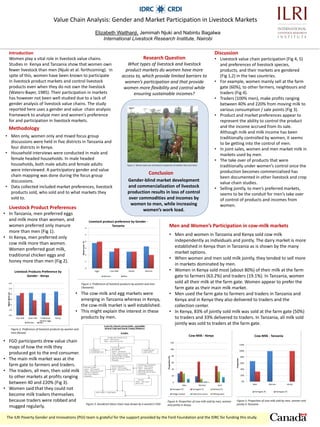
Value chain analysis: Gender and market participation in livestock markets
- 1. Value Chain Analysis: Gender and Market Participation in Livestock Markets Elizabeth Waithanji, Jemimah Njuki and Nabintu Bagalwa International Livestock Research Institute, Nairobi Introduction Discussion Women play a vital role in livestock value chains. Research Question • Livestock value chain participation (Fig 4, 5) Studies in Kenya and Tanzania show that women own What types of livestock and livestock and preferences of livestock species, fewer livestock than men (Njuki et al. forthcoming). In product markets do women have more products, and their markets are gendered spite of this, women have been known to participate access to, which provide limited barriers to (Fig 1,2) in the two countries. in livestock product markets and control livestock women’s participation and that provide • For example, women mainly sell at the farm products even when they do not own the livestock women more flexibility and control while gate (60%), to other farmers, neighbours and (Waters-Bayer, 1985). Their participation in markets ensuring sustainable incomes? traders (Fig 4). has however not been well studied due to a lack of • Traders (100% men), make profits ranging gender analysis of livestock value chains. The study between 40% and 220% from moving milk to reported here uses a gender and value chain analysis various consumption / sale points (Fig 3). framework to analyze men and women’s preference • Product and market preferences appear to for and participation in livestock markets. represent the ability to control the product Methodology and the income accrued from its sale. Although milk and milk income has been • Men only, women only and mixed focus group traditionally controlled by women, it seems discussions were held in five districts in Tanzania and to be getting into the control of men. four districts in Kenya. • In joint sales, women and men market milk in • Household interviews were conducted in male and markets used by men. female headed households. In male headed • The take over of products that were households, both male adults and female adults Figure 1: Women take care of livestock irrespective of whether they own them traditionally under women’s control once the were interviewed. A participatory gender and value production becomes commercialized has chain mapping was done during the focus group Conclusion been documented in other livestock and crop discussions. Gender-blind market development value chain studies. • Data collected included market preferences, livestock and commercialization of livestock • Selling jointly, to men’s preferred markets, products sold, who sold and to what markets they production results in loss of control seems to be the conduit for men’s take over sold to. over commodities and incomes by of control of products and incomes from women to men, while increasing women. Livestock Product Preferences women’s work load. • In Tanzania, men preferred eggs and milk more than women, and Livestock product preference by Gender - women preferred only manure 6 Tanzania Men and Women’s Participation in cow-milk markets more than men (Fig 1). 5 • Men and women in Tanzania and Kenya sold cow milk • In Kenya, men preferred only 4 independently as individuals and jointly. The dairy market is more cow milk more than women. Mean score /5 established in Kenya than in Tanzania as is shown by the many Women preferred goat milk, 3 market options. traditional chicken eggs and 2 • When women and men sold milk jointly, they tended to sell more honey more than men (Fig 2). 1 in markets dominated by men. • Women in Kenya sold most (about 80%) of their milk at the farm 0 Livestock Products Preference by Eggs Cow Milk Honey Manure Gender - Kenya Women Men gate to farmers (63.2%) and traders (19.1%). In Tanzania, women 6.0 Figure 1: Preference of livestock products by women and men sold all their milk at the farm gate. Women appear to prefer the 5.0 (Tanzania) farm gate as their main milk market. • The cow-milk and egg markets were • Men used the farm gate to farmers and traders in Tanzania and Mean Score / 5 4.0 3.0 emerging in Tanzania whereas in Kenya, Kenya and in Kenya they also delivered to traders and the 2.0 the cow-milk market is well established. collection center. 1.0 • This might explain the interest in these • In Kenya, 83% of jointly sold milk was sold at the farm gate (50%) 0.0 Cow milk Goat milk Traditional Honey products by men. to traders and 33% delivered to traders. In Tanzania, all milk sold chicken eggs Women Men jointly was sold to traders at the farm gate. Figure 2: Preference of livestock products by women and men (Kenya) Cow-Milk - Kenya Cow-Milk - Tanzania • FGD participants drew value chain 120 120% maps of how the milk they 100 100% produced got to the end consumer. 80 • The main milk market was at the Proportion (%) 80% Proportion 60 60% farm gate to farmers and traders. • The traders, all men, then sold milk 40 40% to other markets at profits ranging 20 20% between 40 and 220% (Fig 3). 0 Men Women Joint 0% Men Women Jointly • Women said that they could not Farmgate (F) Farmgate (T) Delivery (T) Farmgate (F) Farmgate (T) become milk traders themselves Village market Collection centre Chilling plant because traders were robbed and Figure 4: Proportion of cow milk sold by men, women Figure 5: Proportion of cow milk sold by men, women and Figure 3: Gendered Value chain map drawn by a women’s FGD and jointly in Kenya jointly in Tanzania mugged regularly. The ILRI Poverty Gender and Innovations (PGI) team is grateful for the support provided by the Ford Foundation and the IDRC for funding this study.
